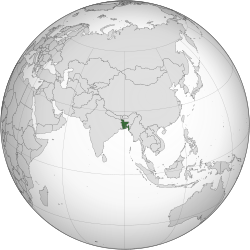 Location of Bangladesh (dark green) | |
| Medicinal | Illegal |
|---|---|
| Recreational | Illegal |
The cultivation, transport, sale, purchase, and possession of all forms of cannabis has been illegal in Bangladesh since the late 1980s, but enforcement efforts are lax and the drug continues to be popular there. Since 2017, enforcement has become harsh on marijuana laws and the government has been cracking down on cannabis.